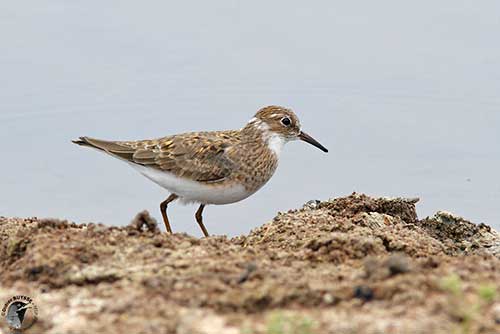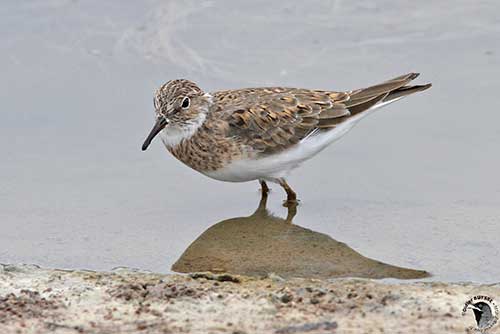
Fr: Bécasseau de Temminck
Ang: Temminck’s Stint
All: Temminckstrandläufer
Esp: Correlimos de Temminck
Ita: Gambecchio nano
Nd: Temmincks Strandloper
Sd: mosnäppa
Photographers:
Didier Buysse
Vision d’Oiseaux
Otto Plantema
Trips around the world
Ingo Waschkies
Bird Photography
Text by Nicole Bouglouan
Sources:
HANDBOOK OF THE BIRDS OF THE WORLD Volume 3 by Josep del Hoyo-Andrew Elliott-Jordi Sargatal - Lynx Edicions - ISBN: 8487334202
SHOREBIRDS by Peter Hayman, John Marchant and Tony Prater – Christopher Helm – 1986 – ISBN: 0747014035
THE HANDBOOK OF BIRD IDENTIFICATION FOR EUROPE AND THE WESTERN PALEARCTIC by Mark Beaman, Steve Madge - C. Helm - ISBN: 0713639601
GUIDE DES LIMICOLES de D. Taylor - Delachaux et Niestlé - ISBN : 2603014080
A Field Guide to the Birds of South-East Asia by Craig Robson. New Holland Publishers. ISBN: 9781780090498
BIRDS OF AFRICA SOUTH OF THE SAHARA by Ian Sinclair and Peter Ryan - Princeton University Press Princeton and Oxford - ISBN: 0691118159
BIRDS OF THE MIDDLE EAST by R.F. Porter, S. Christensen, P Schiermacker-Ansen C.Helm - ISBN: 0713670169
Wikipedia, the free encyclopaedia
What Bird-The ultimate Bird Guide (Mitchell Waite)
THE BREEDING BEHAVIOUR OF TEMMINCK'S STINT
Bird Field Guide -Temminck's Stint (Calidris temminckii)
Temminck’s Stint
Calidris temminckii
Charadriiformes Order – Scolopacidae Family
INTRODUCTION:
The Temminck’s Stint is a tiny, short-legged wader with horizontal look and long tail with white outer rectrices. It breeds on tundra in the northernmost regions of Eurasia, and winters in tropical Africa and S Asia.
Its small size involves distinctive feeding behavior. The bird moves by creeping along the edges of the water, in mouse-like motion.
The Temminck’s Stint is threatened by nest predation, deterioration of suitable habitat and human disturbance. Some local declines are already reported, due to climate change in boreal zones. However, it is currently evaluated as Least Concern.
The name of this species pays tribute to the Dutch naturalist Coenraad Jacob Temminck.

DESCRIPTION OF THE BIRD:
Biometrics:
Length: 13-15 cm
Wingspan: 34-37 cm
Weight: 15-36 g
The Temminck’s Stint in breeding plumage has dull grey to olive-brown upperparts. In fresh plumage, mantle and scapular feathers show blackish centres, pale rufous fringes and grey tips. The tail is like the upperparts with white outer rectrices and darker central pair. The rump shows the same pattern.
On the underparts, chin, throat and belly are white. The breast is grey-brown and heavily streaked brown. The underwing is white with some greyish across the primary coverts.
The head is grey-brown. The bill is blackish with paler base of lower mandible. It is slender, tapering to a fine point. The eyes are dark brown. Legs and feet may vary from greenish to yellow/yellowish-brown, sometimes very dark.
Male and female are similar.
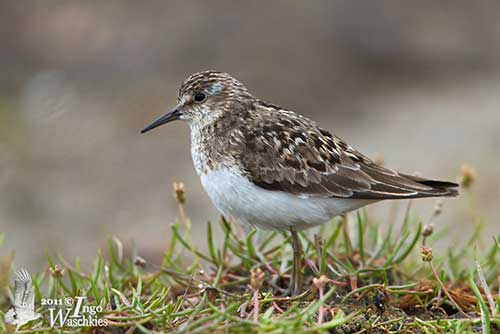
The non-breeding adult has dark grey-brown upperparts and head. The breast is dull grey-brown with paler centre. Chin and throat are white. Legs and feet are sometimes bright yellow.
The juvenile resembles non-breeding adult with brown-grey upperpart feathers with dark subterminal band and deep buff fringes, involving slightly scaled pattern. A buff-brown breast band is usually complete.
RANGE:
The Temminck’s Stint breeds in Scandinavia through NW Russia and N Siberia, E to Chukotskiy Peninsula and Anadyrland, and irregularly in Britain.
It winters from Mediterranean, N tropical Africa and Middle East, through Indian Subcontinent and Indochina to S China, Taiwan and S Ryukyu Islands, and S to Peninsular Malaysia and Borneo, occasionally to Philippines.
HABITAT:
The Temminck’s Stint breeds on tundra, but it avoids the severe Arctic conditions by choosing more sheltered areas, often on woodland fringes, sometimes around human habitations. It frequents floodplains in forest tundra, and can be seen up to 1200 metres of elevation. It also nests in areas with short grass and scattered patches of shrubs, in fjords, deltas, streams and near inlets.
During winter, it frequents a variety of wetland habitats, mainly inland freshwater sites such as irrigated fields, sewage farms and vegetated wetlands. It is more rarely seen on open coasts and coastal salt-water habitats.
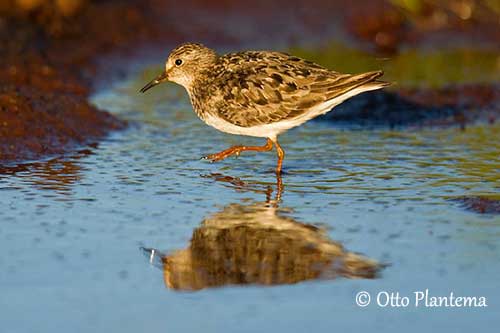
CALLS AND SONGS: SOUNDS BY XENO-CANTO
The Temminck’s Stint in flight gives distinctive, rapid stuttering “tirrr” often repeated, or more prolonged “tirrr-r-r”. During the displays, it utters a rhythmic, rising and falling, continuous trilling “kilililililili…” or “sirrrrrr…” often sustained for several minutes.
BEHAVIOUR IN THE WILD:
The Temminck’s Stint has a distinctive “mouse-like” feeding behavior. It feeds on insects and their larvae (Coleopterans and Dipterans), and other small invertebrates such as annelids, crustaceans and small mollusks. It may occasionally take some plant material.
It forages by creeping steadily along the edges of the water, pecking prey from the surface. It rarely probes with the bill.
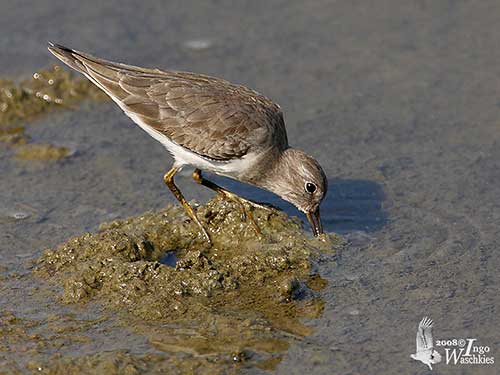
The Temminck’s Stint is usually seen singly or in small groups, but up to 200 individuals may gather on migration. If threatened or approached, it crouches against the ground. If flushed, it raises rapidly with fast, jinking flight.
At the beginning of the breeding season, the male performs spectacular display flight, hovering or circling during several minutes while singing. It flies above the territory with spread tail, in order to display the dark and white pattern, and the wings held up in V-shape, like hanging in the wind.
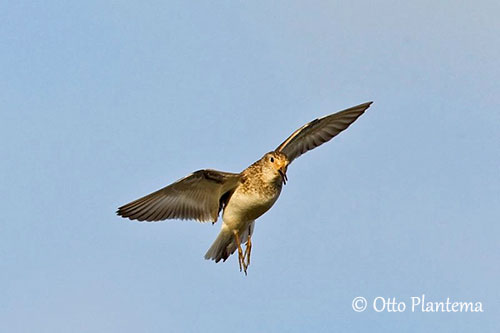
When the male has alighted on stone or bush after this flight, it often remains perched while singing, with the wings stretched up and flickered. The same display is performed prior to copulation.
Other ground displays show the male singing continuously while fanning its wings, walking from its perch (usually a stone on the ground) to a shallow scrape dug in the territory, in front of a female. The ground display follows the aerial displays.
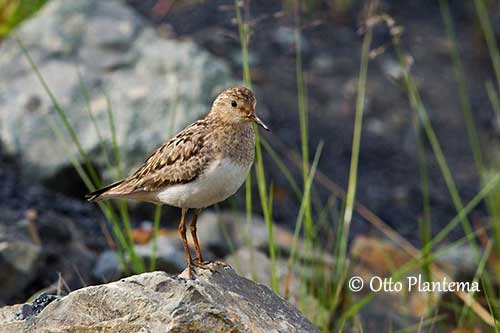
The breeding behavior of the Temminck’s Stint is a rapid, double-clutch system, involving bigamy by both sexes. However, only one adult cares for the clutch and the brood.
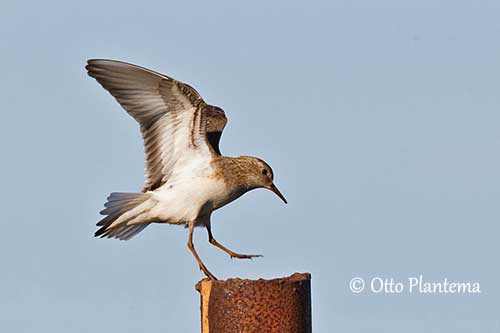
The Temminck’s Stint is migratory, and migrates in flocks of 150/250 individuals. They leave the wintering areas in late March/April, some as late as May. The migration takes one month to complete.
There are some vagrants to Australia, Azores, Cape Verde, Seychelles, Iceland, N Greenland and N America.
When flushed, the Temminck’s Stint climbs quickly into the sky. It may fly slowly sometimes, with arched wings.
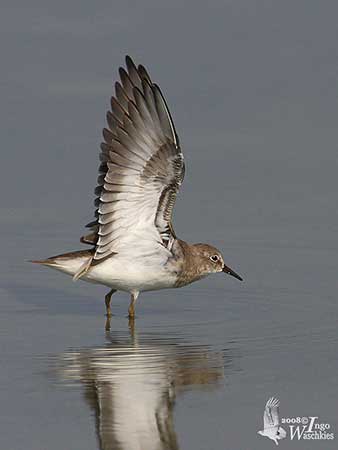
REPRODUCTION OF THIS SPECIES:
The breeding season takes place in spring, with the egg-laying from late May to early July. The pair bond typically lasts one week, and some males may perform extra-pair copulations if they do not incubate. There are territorial until the beginning of the incubation. They nest in loose colonies with less than 180 metres between the nests.
The Temminck’s Stint nests on the ground in a shallow depression in open or low vegetation. The nest is lined with stems, leaves and moss.
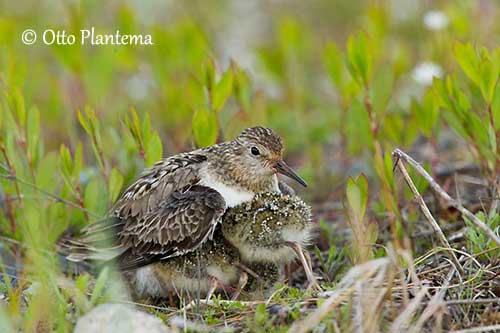
The female lays 2-4 cryptic eggs. A second clutch is started almost immediately, between 2 and 9 days after the first one. Each nest is cared for by one adult, the male first. The incubation lasts three weeks. At hatching, the chicks have cinnamon-buff down above and white below. Face and throat are buff-yellow. They fledge 15-18 days after hatching.
Flooding and nest predation are the main causes of nest failure. The Common or Mew Gull and the Ruddy Turnstone are the main predators in Finland.
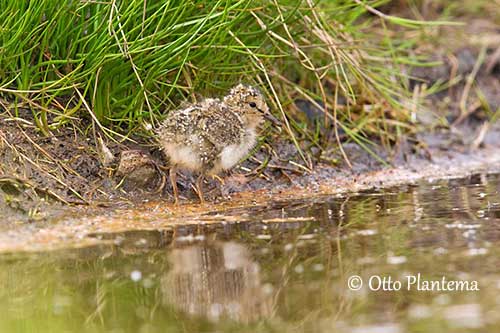
PROTECTION / THREATS / STATUS:
The Temminck’s Stint is threatened by nest predation (both birds and mammals), deterioration of suitable habitats by overgrazing, and human disturbance by recreational activities, involving abandonment of nests.
The global population was estimated at 170,000/1,300,000 individuals in 2006, and the trend is difficult to determine.
But currently, the Temminck’s Stint is evaluated as Least Concern.
